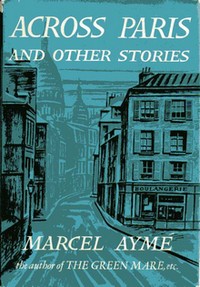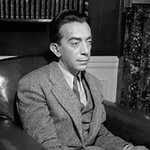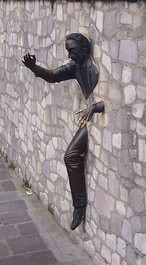
I’m always amazed that, in the English-speaking world, the works of Marcel Aymé aren’t given a smidgen of the critical and popular attention paid to Sartre, Camus, de Beauvoir, and even Queneau. There certainly seems to be some preset filter that blocks the passage of any French writer with at least a 50/50 ratio of theory to art.
Against such a filter, Aymé couldn’t stand a chance. “People will be people” is probably as much of a philosophy as he ever bothered with. And people, in all their quirks, prejudices, bad habits and good, their love for food, wine, sex, and politics, their dreams and nightmares, were something he found endlessly fascinating.
Across Paris comprises a dozen of Aymé’s short stories culled by translator Norman Denny from a half-dozen collections published in France between 1932 and 1950. (Denny published another collection, The Proverb, in 1961). It’s an excellent introduction to Aymé’s unique approach, which manages to juggle earthy humor, wild fantasy, tender affection, and wry skepticism without too many slips or collisions.
 The title story Across Paris was made into a highly successful comedy starring Jean Gabin, La Traversée de Paris, in 1956. In Aymé’s original, however, the story of two men smuggling 200 pounds of black market pork through Nazi-occupied Paris ends in murder, and illustrates the violent tension between existentialism and the older world of tradition, rules, and manners. At least, that’s the underlying conflict that drives the story. Aymé would never have bothered to be so crude as to drag a message into his writing.
The title story Across Paris was made into a highly successful comedy starring Jean Gabin, La Traversée de Paris, in 1956. In Aymé’s original, however, the story of two men smuggling 200 pounds of black market pork through Nazi-occupied Paris ends in murder, and illustrates the violent tension between existentialism and the older world of tradition, rules, and manners. At least, that’s the underlying conflict that drives the story. Aymé would never have bothered to be so crude as to drag a message into his writing.
Aymé’s most famous story, “Le Passe-Muraille”, here translated as “The Walker-Through-Walls” also appears in Across Paris. This tale is an example of Aymé’s gift for fantasy. A middle-aged clerk suddenly discovers one day that he can pass through walls, doors, and other solid matter with little effort. At first he merely attempts it for the novelty, but soon he uses it to indulge his vices. A theft here and there leads to sneaking into bank vaults and jewelry stores. In the end, as he leaves the bed of a woman he has seduced, his powers suddenly fail, trapping him forever inside a wall.
 The sculptor Jean Marais paid tribute to this story with a statue that can be found in the Place Marcel Aymé in Montmartre. The statue captures Aymé emerging from the wall just like his character.
The sculptor Jean Marais paid tribute to this story with a statue that can be found in the Place Marcel Aymé in Montmartre. The statue captures Aymé emerging from the wall just like his character.
Another story, “Martin the Novelist” may remind some readers of the work of Raymond Queneau. Martin’s formula, through a dozen or more successful novels, has been to have his lead character die some tragic death near the end. No matter how he tries, each protagonist winds up dead. As he starts his newest book, however, the protagonist’s wife pays a call on him to plea for her husband’s life. The situation quickly gets more complicated as Martin’s publisher falls in love with the woman. Suddenly, the publisher tries to conspire to have Martin eliminate the husband. Martin and we both find it increasingly difficult to tell fiction from reality. It’s a sign of Aymé’s skill that everything flows smoothly along despite the fact that we all left disbelief behind somewhere around the story’s second or third paragraph.
Hardly anything by Aymé remains in print in English today. His children’s story, The Wonderful Farm, is available, probably due as much to its illustrations by Maurice Sendak. And very recently, Pushkin Press released a new translation of “La belle image”, Beautiful Image, which has variously been issued in the past as The Second Face and The Grand Seduction.
Karen Reshkin has published her own translations of “Le Passe Muraille” (“The Man Who Could Walk Through Walls”) and several other Aymé stories on her StressCafe website.
Locate a Copy
Across Paris, by Marcel Aymé
New York: Harper, 1950

 In Commentary magazine
In Commentary magazine  Bourjaily’s is among the names most often mentioned in the emails I receive from site visitors. Dronamraju covers the two Bourjaily novels I’ve always been most intrigued by:
Bourjaily’s is among the names most often mentioned in the emails I receive from site visitors. Dronamraju covers the two Bourjaily novels I’ve always been most intrigued by: 
 The title story
The title story  The sculptor Jean Marais paid tribute to this story with a statue that can be found in the Place Marcel Aymé in Montmartre. The statue captures Aymé emerging from the wall just like his character.
The sculptor Jean Marais paid tribute to this story with a statue that can be found in the Place Marcel Aymé in Montmartre. The statue captures Aymé emerging from the wall just like his character.